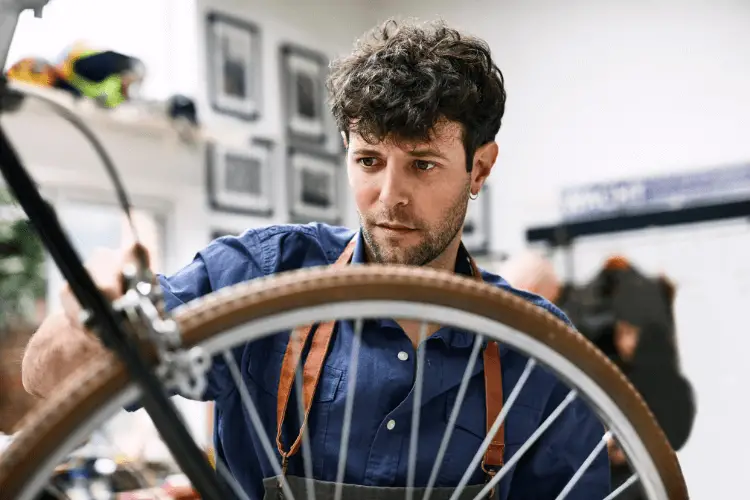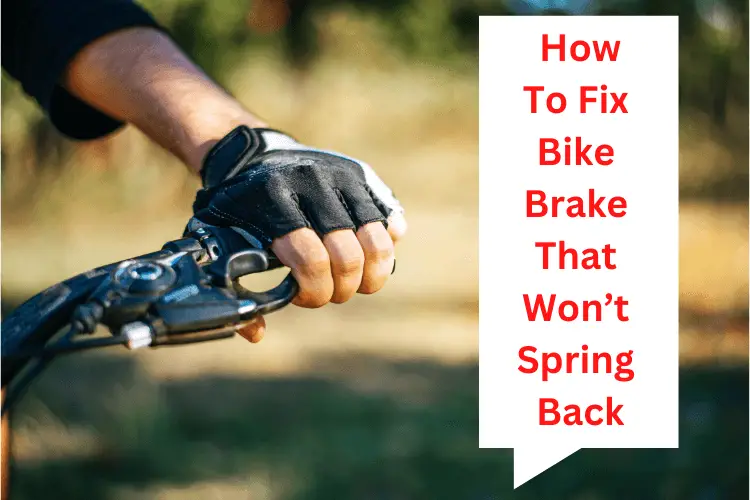Bike brakes that won’t spring back can be fixed by changing the problematic parts or outright changing the entire brake system. Whichever method you choose, your safety is the most important thing.
If your bike brakes will not spring back, it can either be due to a lack of compression from a broken or worn-out cable casing. It can also be due to an improperly adjusted brake on the wheel rim.
Before you can start fixing your bike brakes, you first need to know why the brakes won’t spring back. There are a few different reasons, some more serious than others.
So, in this article, we have covered the major reasons why brakes don’t spring back and provided 9 fixing guides.
Quick Navigation
Why Don’t Bike Brakes Spring Back?
Bike brakes don’t spring back either due to too much friction of its spring or a brake spring that is broken or not correctly adjusted.

There are a few reasons why a bike brake won’t spring back.
Here are some of the reasons :
i. Rusted Pistons
This is one of the reasons that cause a bike brake not to spring back. It is expected that after the cyclist releases the lever, the pads should bounce back into place.
Just a little bit away from the wheel allows the bike to continue riding. But this doesn’t happen when the piston is rusted.
ii. Too Much Friction
Friction is the force that keeps two surfaces from moving when they are in contact. When there is too much friction, it affects the brakes from springing back.
iii. Damaged Fitted Brake Spring
A damaged spring is another reason for bike brakes won’t spring back. Brake springs should regularly check to know when they need to change. This is because a damaged spring is dangerous to the rider and other road users.
iv. Incorrectly Fitted Brake Spring
Brakes are generally not things to be toyed with. Fitting your bike by someone who is not a professional can be risky.
This is because the individual can do haphazard maintenance on your bike brakes and damage your brake system. Then when you try to apply the brakes while in motion, they’ll fail.
v. Corrosion
Corrosion is a major reason for brakes won’t snap back. The brake system has other components, of which calipers are one of them.
These calipers are susceptible to rust, making them adhere to the pad when the brake is applied.
vi. Damaged Brake Pads
Another scenario may be a damaged brake pad. When the brake is damaged, it is best to change it rather than managing it.
We have another article for you Why Bike Chain Won’t Go Backward and how to fix the problem.
How To Fix Bike Brake That Won’t Spring Back

There are several ways to fix bike breaks that won’t spring back, but in this part of the article, we will cover 9 ways to fix bike breaks that won’t spring back.
1. Check Brake Pads Rust
Brake pads can deteriorate with time and rust. A brake pad that has been worn down will not function properly, no matter what else you do.
Rust can wear down brake pads and cause them not to spring back.
Please verify that the brake pads are not rusted and are larger than one-fourth of an inch in size. If not, they need to be changed, or you risk crashing due to a brake failure.
2. Check the Brake Fluid
Just as it is impossible to stay without, your bike’s brake system will unlikely work without fluid. Your brake system will not spring back properly if you do not feed it with brake fluid from time to time.
When refilling brake fluid, make sure to use the right kind of fluid. The user manual for your bike should include this information. Most models frequently include step-by-step directions on how to replace the fluid.
3. Check the Brake Cables
Check the brake cables because they need to be fixed or replaced if they are broken. A broken cable can’t send signals to the brake mechanism.
So if your bike brake won’t spring back, this is the first thing you should check.
Ensure the tension on your cables is proper by adjusting it; rotating the cable barrel on the handle lever.
4. Oil the Brake Cables
You can lubricate your bike’s brake cables by spraying lubricant into the brake cable’s housing, which is behind the brake levers.
Remember that just a little bit of oil sufficiently lubricate your cables. This is one thing you can do when your bike brake won’t spring back.
5. Oil the Lever Pivots
The brake pivots, which are close to the brake lever, need to be oiled. Make sure to apply a tiny amount of bicycle lubricant or machine oil to each pivot pin.
Avoid getting any of it on the brake pads, the rims, or the rotor to avoid having ineffective brakes!
6. Make Sure Brake Pad Doesn’t Have Any Lips
Lips shouldn’t be visible on the side of the brake pad closest to the hub. It should be filed away so it won’t get in the way when braking.
Lips result from the brake pad wearing down unevenly. Sandpaper can be used to do this until the wheel spins freely.
7. Examine and Clean the Tube
Because the bicycle is exposed to rain and air, the brake cable housing can sometimes get rusty or stiff.
By releasing the brake lever’s clasp and sliding the plastic tube out of the other end, you can remove it.
Use an aerosol solvent to clean the case. After making sure the casing is undamaged, carefully re-insert the cable.
8. Adjust the Calipers
The calipers on rim brakes need to be adjusted since they play a significant role in the brake pads’ tendency to spring back.
After unscrewing the brakes from the brake pads, ensure they are three to five millimeters away from the tire rim.
Before trying the brakes to determine if they still stick, tighten the brake pad and spin the wheel.
Read our another trouble shooting article on How To Fix Bike Pedal Won’t Screw In, We have provided ultimate guide for you.
9. Consult A Technician
Even though it’s respectable and fun to try to fix your bike on your own, sometimes it’s better to leave it to the pros.
You can use expert help as much as you want and even have them fix your bikes sometimes.
Conclusion
Bike brakes that won’t spring back are a common problem, but there are several ways you can try to fix the issue.
If your bike brake won’t spring back, it can be due to a lack of compression from a broken or worn-out cable casing.
It can also be due to an improperly adjusted brake on the wheel rim. Regardless of the cause, you sure can’t go wrong with the steps mentioned above.
Do these checks occasionally, and your cycling experience will be enjoyable.

2 thoughts on “9 Ways To Fix Bike Brake That Won’t Spring Back”